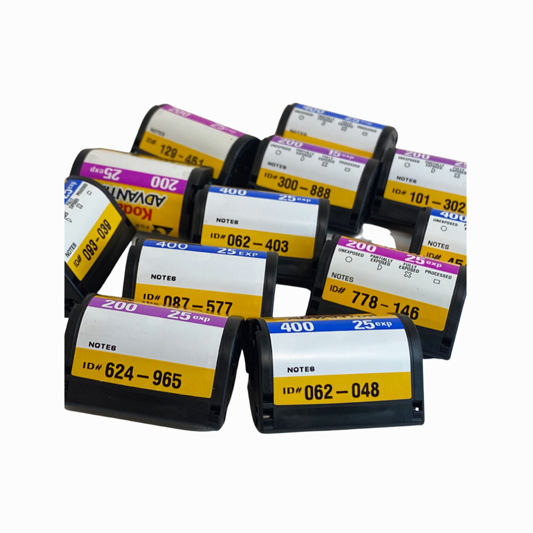[Read Time: 4.2 minutes]
Throwback to when APS film was the future of photography. Who else remembers this once game-changing film format?
The History of APS Film:
 APS film, also known as Advanced Photo System film, was a type of photographic film introduced in 1996 by a consortium of several major camera and film manufacturers. APS film was designed to replace traditional 35mm film and offer several innovative features.
APS film, also known as Advanced Photo System film, was a type of photographic film introduced in 1996 by a consortium of several major camera and film manufacturers. APS film was designed to replace traditional 35mm film and offer several innovative features.
Unlocking the Wonders of APS Film: User-Friendly and Beyond.
The history of APS film can be traced back to the early 1990s when Kodak, Fuji, Canon, Minolta, Nikon, and other companies collaborated to develop a new film format. They aimed to create a user-friendly system that would appeal to a wider range of consumers and simplify various aspects of film photography.
APS film offered several advantages over traditional 35mm film. One key feature was the cartridge design, which allowed the film to be loaded and unloaded without exposing it to light. This made it easier and more convenient for users to handle the film, especially in daylight.
APS Film Formats:
Another significant feature of APS film was its three selectable image formats: Classic, HDTV, and Panoramic. These formats offered different aspect ratios, allowing photographers to choose the desired composition for their images. Additionally, the film had a magnetic coating that allowed for data recording, enabling the camera to store metadata such as date, time, and exposure information.
 APS cameras were designed to take advantage of these features. They were typically compact and offered automated functions, making them more accessible to casual photographers. The cameras had motorized film transport, allowing easy film loading and rewinding. They also often included advanced features like autofocus, automatic exposure control, and built-in flashes.
APS cameras were designed to take advantage of these features. They were typically compact and offered automated functions, making them more accessible to casual photographers. The cameras had motorized film transport, allowing easy film loading and rewinding. They also often included advanced features like autofocus, automatic exposure control, and built-in flashes.
Despite the promising features, APS films faced some challenges. One of the main hurdles was its compatibility with existing photographic infrastructure. Unlike 35mm film, APS film requires dedicated APS cameras and specialized processing equipment. This limited the adoption of APS film, as photographers and processing labs had to invest in new equipment.
The Rise and Fall: APS Film Meets the Digital Revolution.
As digital photography began to gain popularity in the early 2000s, APS film faced a decline. Digital cameras offered the convenience of immediate image review, unlimited storage capacity, and easy sharing, which attracted many photographers. The demand for APS film diminished, and by the mid-2000s, major film manufacturers started discontinuing APS film production.
Today, APS film is considered a relic of the past.
While some enthusiasts may still use APS cameras and hunt for expired film stock, the format has become increasingly rare. The rise of digital photography and the subsequent decline of traditional film formats played a significant role in the decline of APS film.
The challenge is that most APS film is still analog, not viewed or digitized. For $7.95 per exposure, you can quickly get everything digitized from 15 to 40 pictures.



